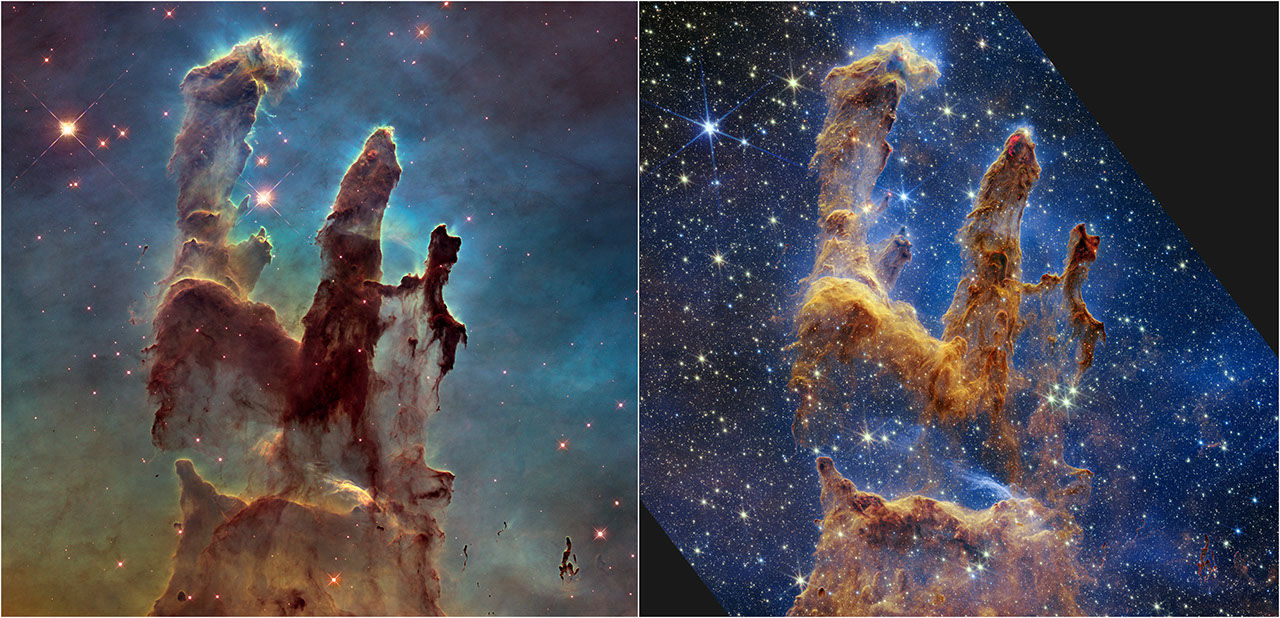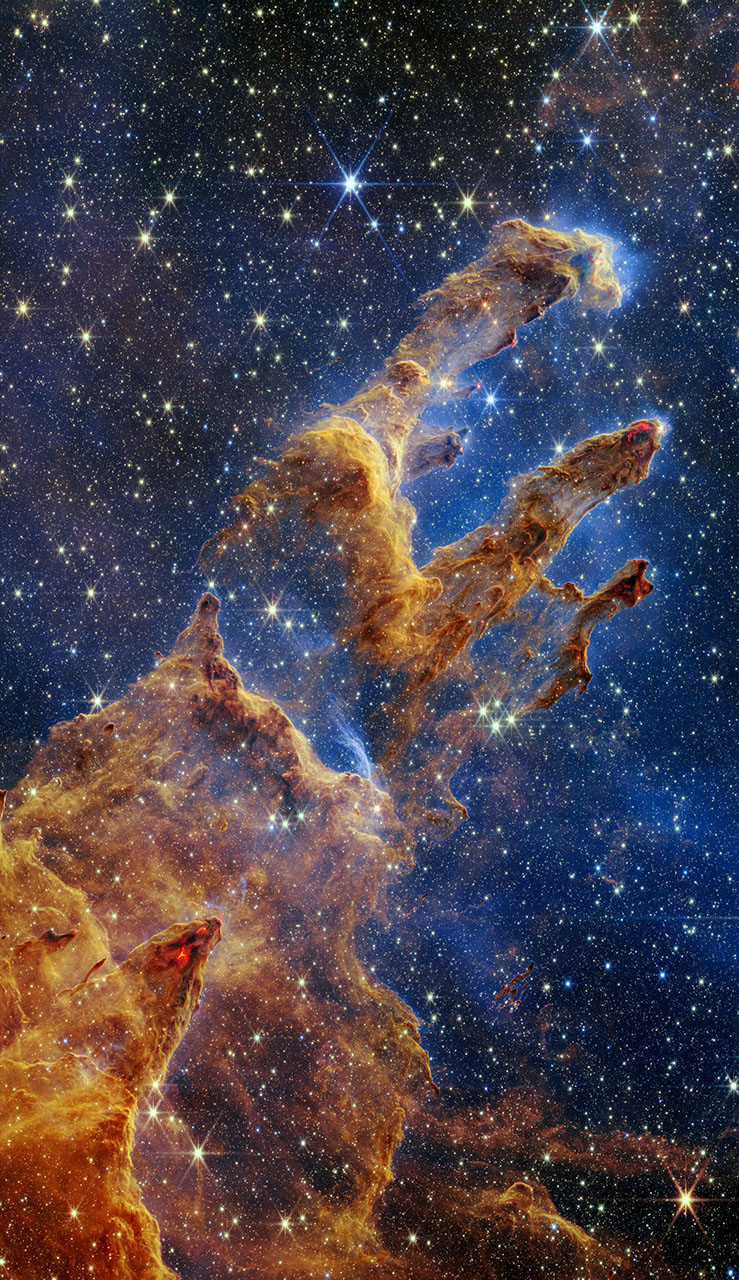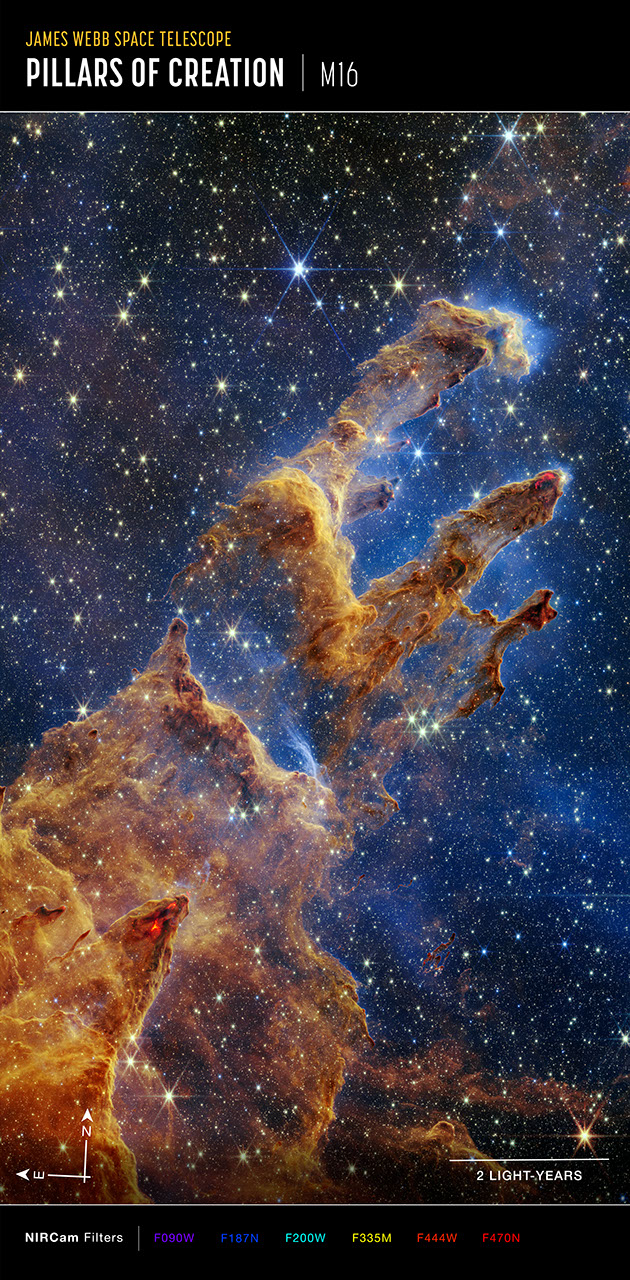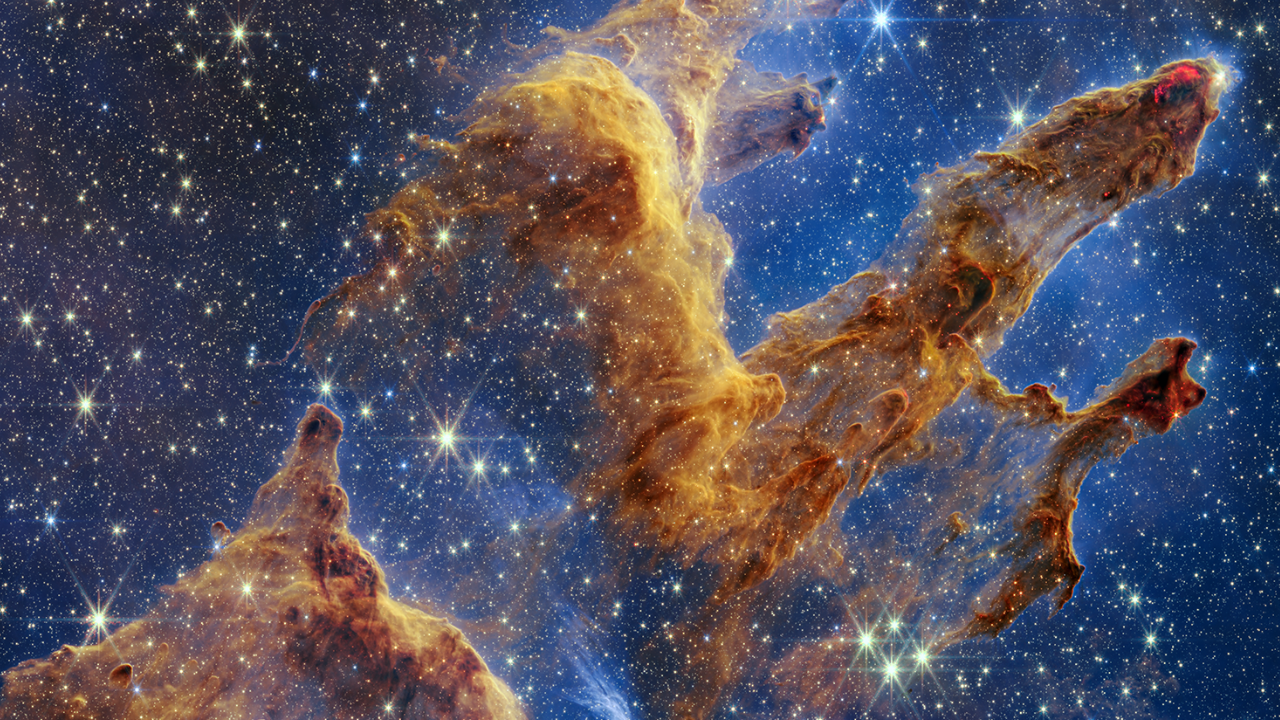1 min read
Pillars of Creation (Hubble and Webb Images Side by Side)

NASA's Hubble Space Telescope made the Pillars of Creation famous with its first image in 1995, but revisited the scene in 2014 to reveal a sharper, wider view in visible light, shown above at left.
A new, near-infrared-light view from NASA’s James Webb Space Telescope, at right, helps us peer through more of the dust in this star-forming region. The thick, dusty brown pillars are no longer as opaque and many more red stars that are still forming come into view.
While the pillars of gas and dust seem darker and less penetrable in Hubble’s view, they appear more diaphanous in Webb’s.
The background of this Hubble image is like a sunrise, beginning in yellows at the bottom, before transitioning to light green and deeper blues at the top. These colors highlight the thickness of the dust all around the pillars, which obscures many more stars in the overall region.
In contrast, the background light in Webb’s image appears in blue hues, which highlights the hydrogen atoms, and reveals an abundance of stars spread across the scene. By penetrating the dusty pillars, Webb also allows us to identify stars that have recently – or are about to – burst free. Near-infrared light can penetrate thick dust clouds, allowing us to learn so much more about this incredible scene.
Both views show us what is happening locally. Although Hubble highlights many more thick layers of dust and Webb shows more of the stars, neither shows us the deeper universe. Dust blocks the view in Hubble’s image, but the interstellar medium plays a major role in Webb’s. It acts like thick smoke or fog, preventing us from peering into the deeper universe, where countless galaxies exist.
The pillars are a small region within the Eagle Nebula, a vast star-forming region 6,500 light-years from Earth.
About the Object
- R.A. PositionR.A. PositionRight ascension – analogous to longitude – is one component of an object's position.18:18:48.17
- Dec. PositionDec. PositionDeclination – analogous to latitude – is one component of an object's position.-13:48:26.03
- ConstellationConstellationOne of 88 recognized regions of the celestial sphere in which the object appears.Serpens
- DistanceDistanceThe physical distance from Earth to the astronomical object. Distances within our solar system are usually measured in Astronomical Units (AU). Distances between stars are usually measured in light-years. Interstellar distances can also be measured in parsecs.6,500 light-years (2,000 parsecs)
- DimensionsDimensionsThe physical size of the object or the apparent angle it subtends on the sky.Image is approximately 8 light-years across.
About the Data
- Data DescriptionData DescriptionProposal: A description of the observations, their scientific justification, and the links to the data available in the science archive.
Science Team: The astronomers who planned the observations and analyzed the data. "PI" refers to the Principal Investigator. - InstrumentInstrumentThe science instrument used to produce the data.HST>WFC3/UVIS JWST>NIRCam
- Exposure DatesExposure DatesThe date(s) that the telescope made its observations and the total exposure time.Sept 2014, 14 Aug 2022
- FiltersFiltersThe camera filters that were used in the science observations.HST>F502N, F657N, F673N JWST>F090W, F187N, F200W, F335M, F444W, F470N
- Object NameObject NameA name or catalog number that astronomers use to identify an astronomical object.M16, Eagle Nebula, NGC 6611
- Object DescriptionObject DescriptionThe type of astronomical object.Emission Nebula
- Release DateOctober 19, 2022
- Science ReleaseNASA’s Webb Takes Star-Filled Portrait of Pillars of Creation
- CreditNASA, ESA, CSA, STScI, Hubble Heritage Project; Image Processing: Joseph DePasquale (STScI), Anton Koekemoer (STScI), Alyssa Pagan (STScI)

These images are composites of separate exposures acquired by the WFC3 instrument on the Hubble Space Telescope and the NIRCam instrument on the James Webb Space Telescope. Several filters were used to sample different wavelength ranges. The color results from assigning different hues (colors) to each monochromatic (grayscale) image associated with an individual filter. In this case, the assigned colors are: HST Left> Blue: F502N, Green: F657N, Red: F673N Webb Right> Purple: F090W, Blue: F187N, Cyan: F200W, Yellow: F335M, Orange: F444W, Red: F470N
Related Images & Videos

Pillars of Creation (NIRCam Image)
The Pillars of Creation are set off in a kaleidoscope of color in NASA’s James Webb Space Telescope’s near-infrared-light view. The pillars look like arches and spires rising out of a desert landscape, but are filled with semi-transparent gas and dust, and ever changing. This is...

Pillars of Creation (NIRCam Compass Image)
This image of the Pillars of Creation, captured by Webb’s Near-Infrared Camera (NIRCam), shows compass arrows, scale bar, and color key for reference. It lies within the Eagle Nebula, which is also known as Messier 16 (M16). The north and east compass arrows show the orientation...

Webb's New View of the Pillars of Creation (NIRCam)
This video tours areas of Webb’s near-infrared light view of the Pillars of Creation. This area is brimming with gas and dust – which are essential ingredients for star formation. Glowing, bright red wavy lines appear at the edges of some pillars, revealing where stars are...
Share
Details
Laura Betz
NASA’s Goddard Space Flight Center
Greenbelt, Maryland
laura.e.betz@nasa.gov
NASA, ESA, CSA, STScI, Hubble Heritage Project
Joseph DePasquale (STScI), Anton Koekemoer (STScI), Alyssa Pagan (STScI)































